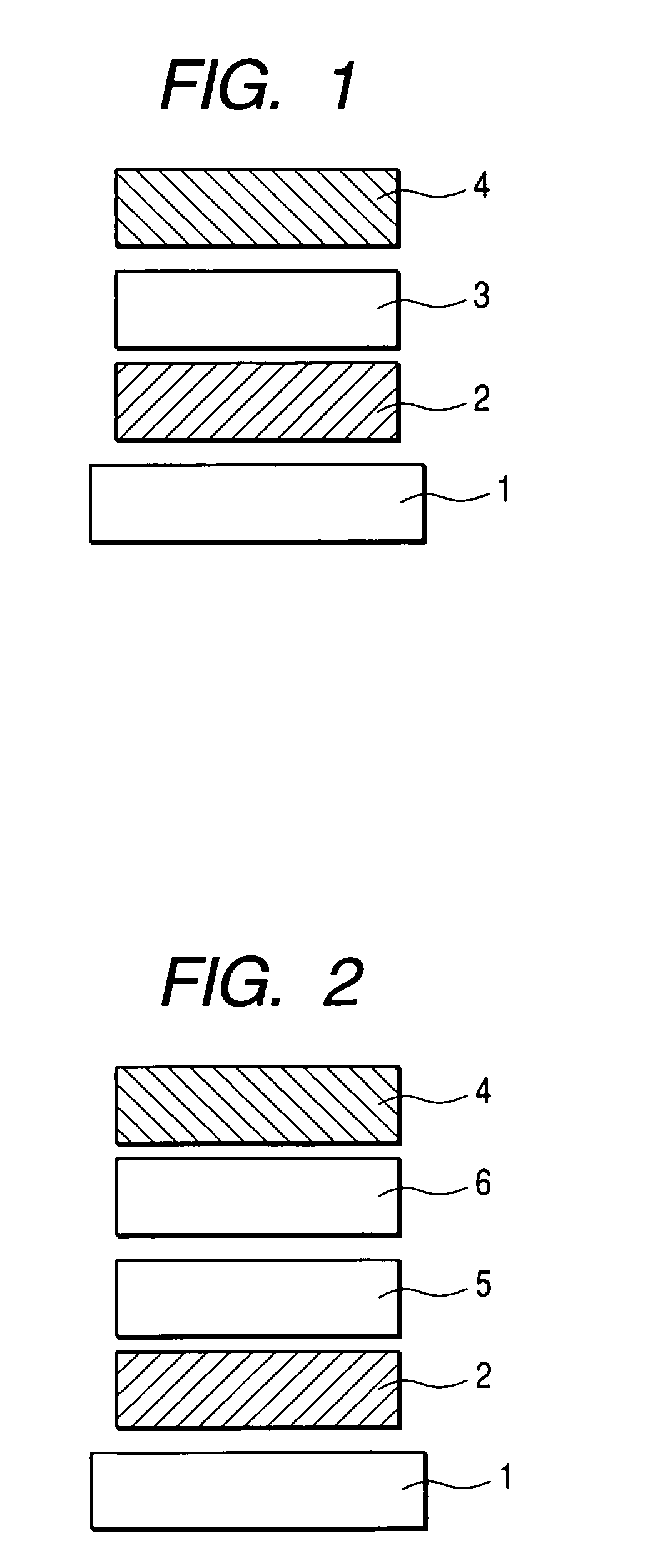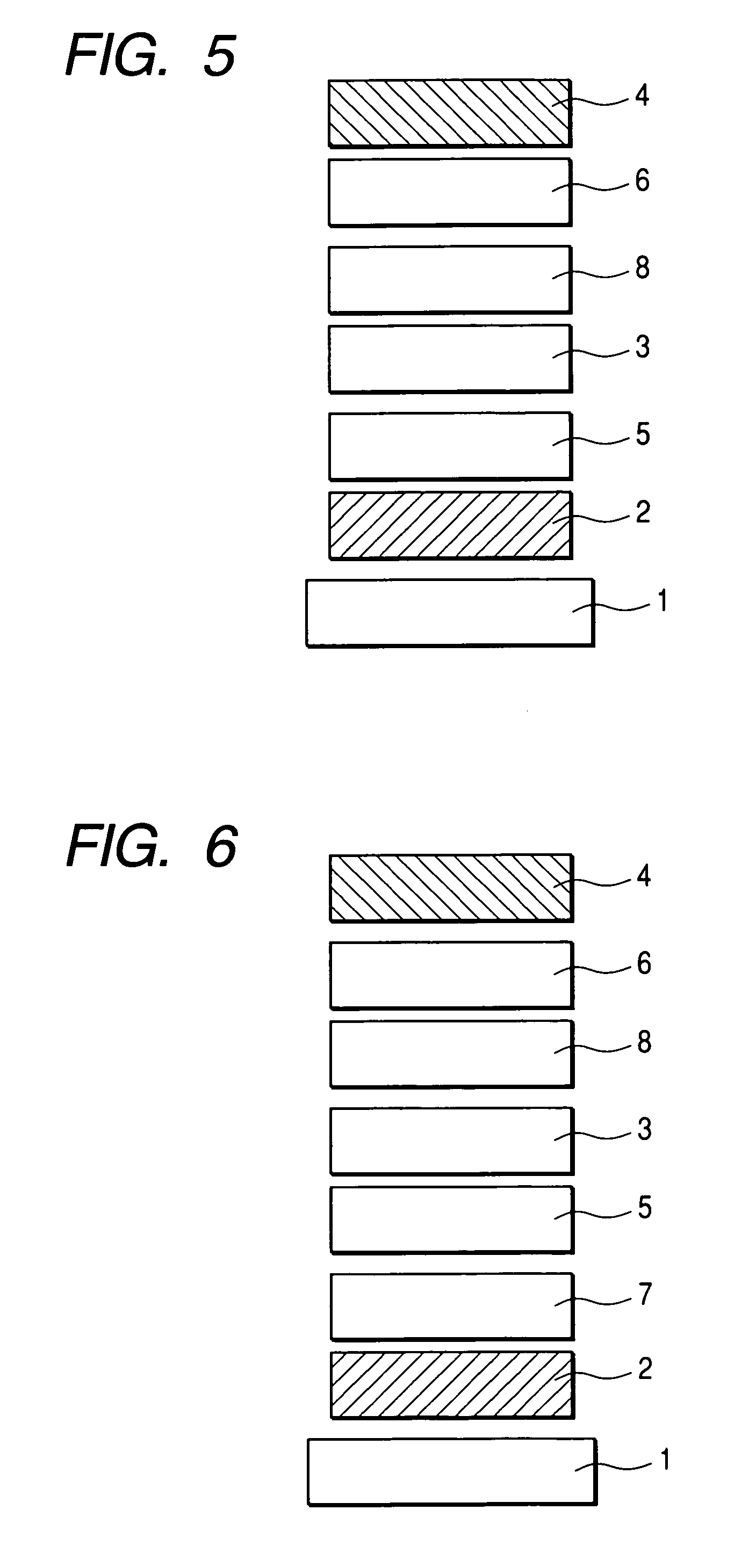Fluorene compound and organic light-emitting device using same
a fluorene compound and organic light-emitting technology, applied in the direction of organic semiconductor devices, solid-state devices, discharge tubes/lamp details, etc., can solve the problems of insufficient current art and many durability problems, and achieve excellent durability, low applied voltage, and high luminance
- Summary
- Abstract
- Description
- Claims
- Application Information
AI Technical Summary
Benefits of technology
Problems solved by technology
Method used
Image
Examples
synthesis example 1
[0118] [Synthesis of Exemplified Compound No. 1]
[0119] To a 500-ml three-neck flask, 2.0 g (5.68 mmol) of 2,7-dibromo-9,9-dimethylfluorene [1], 4.2 g (17.0 mmol) of pyrene-1-boronic acid [2], 120 ml of toluene, and 60 ml of ethanol were added. Then, an aqueous solution of 24 g of sodium carbonate in 120 ml of water was added dropwise therein with stirring in a nitrogen atmosphere at room temperature, followed by the addition of 0.33 g (0.28 mmol) of tetrakis (triphenylphosphine) palladium (0). After stirring the mixture for 30 minutes at room temperature, the temperature was raised to 77° C., followed by stirring for 5 hours. After the reaction, an organic layer was extracted with chloroform and then dried with anhydrous sodium sulfate, followed by purification with a silica gel column (hexane and toluene mixture developing solvent). Consequently, 3.0 g (89% yield) of a compound [3] (white crystal) was obtained.
[0120] To a 500-ml three-neck flask, 3.51 g (5.89 mmol) of compound [3...
synthesis example 2
[0121] [Synthesis of Exemplified Compound No. 14]
[0122] To a 500-ml three-neck flask, 1.50 g (2.52 mmol) of compound [3], 1.61 g (7.55 mmol) of 1-bromoadamantane and 100 ml of dichloromethane were added. The resultant mixture was stirred at 0° C., and then 0.70 g (5.30 mmol) of aluminum chloride was slowly added thereto. After stirring the mixture for 30 minutes at 0° C., the temperature was raised to room temperature, followed by stirring for 5 hours. After the reaction, an organic layer was taken into 200 ml of water, extracted with chloroform and then dried with anhydrous sodium sulfate, followed by purification with a silica gel column (hexane and toluene mixture developing solvent). Consequently, 1.42 g (65% yield) of exemplified compound No. 14 (white crystal) was obtained.
example 1
[0123] A device having the structure shown in FIG. 2 was prepared.
[0124] On a glass substrate as the substrate 1, indium tin oxide (ITO) was deposited to form a film with a thickness of 120 nm by sputtering method to obtain the anode 2, so that the substrate thus formed was used as a transparent conductive support substrate. The substrate was subjected to ultrasonic cleaning sequentially with acetone and with isopropyl alcohol (IPA). Following this, the substrate was washed with IPA through boiling and then dried. Furthermore, the substrate after UV / ozone cleaning was used as the transparent conductive support substrate.
[0125] On the transparent conductive support substrate, a chloroform solution of the compound represented by the following structural formula was applied to form a film of 30 nm in thickness by a spin-coating method, thereby forming the hole-transporting layer 5.
[0126] Furthermore, a fluorene compound represented as exemplified compound No. 1 was deposited to for...
PUM
| Property | Measurement | Unit |
|---|---|---|
| applied voltage | aaaaa | aaaaa |
| thickness | aaaaa | aaaaa |
| thickness | aaaaa | aaaaa |
Abstract
Description
Claims
Application Information
 Login to View More
Login to View More - R&D
- Intellectual Property
- Life Sciences
- Materials
- Tech Scout
- Unparalleled Data Quality
- Higher Quality Content
- 60% Fewer Hallucinations
Browse by: Latest US Patents, China's latest patents, Technical Efficacy Thesaurus, Application Domain, Technology Topic, Popular Technical Reports.
© 2025 PatSnap. All rights reserved.Legal|Privacy policy|Modern Slavery Act Transparency Statement|Sitemap|About US| Contact US: help@patsnap.com



